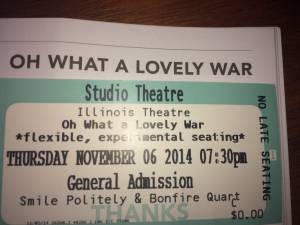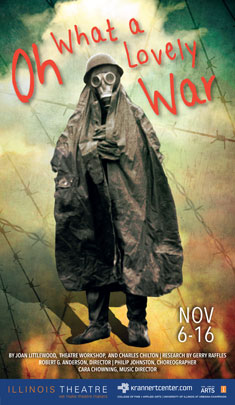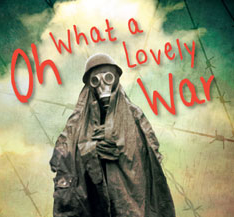This year marks the 100th anniversary of World War I. While veterans and families gather in remembrance of a time forever engraved in history, the Krannert Center is hosting a musical featuring University students that details the good, the bad, and the ugly of a war that affected millions. Add in a few songs, jokes, and constant audience participation, and the show is right before your eyes. Welcome, Ladies and Gentlemen to Oh What a Lovely War.
The Arts are seldom shy when it comes to discussing topics that may be sensitive or taboo to others, and Oh What A Lovely War manages an impressive feat. Not only does it bring the seriousness of a war often forgotten by contemporary audiences to the forefront in a well-played manner, but it dares to be funny when others might have shied away. It brings the topic of war to the face of its viewers. Literally.
 One of the main aspects that helps this show function so spectacularly is the “flexible, experimental” seating (see ticket stub). Upon entering the theatre, patrons find benches lined up in a giant rectangle with open space left in the middle. A live band plays to set the mood, dressed to fit the time period.
One of the main aspects that helps this show function so spectacularly is the “flexible, experimental” seating (see ticket stub). Upon entering the theatre, patrons find benches lined up in a giant rectangle with open space left in the middle. A live band plays to set the mood, dressed to fit the time period.
A woman’s automated voice encourages viewers to sit and narrates what is to come, dropping a few swear words here and there that manage to be timed appropriately. Almost immediately, as the actors and actresses of the opening scene enter into the playing area, they ask guests to stand up from their seats as they rearrange the seating to fit with the scene and its theatrics.
Some opening night viewers — or perhaps I should say participants — looked worried at first as they were ushered by the actors in the scene to move to a corner of the room, but they soon found that this interactive seating kept them literally on their toes. Not only does it help keep a viewer from daydreaming or drifting off, but it paints each scene beautifully for the viewer by calling attention to moments of particular note in the development of the story. No scene is the same, and each brings a different character to life simply because of the seating.
Perhaps surprisingly, the American perspective of the war is barely noted; and yet it works magically. The actors have cleary worked hard practicing different accents for the show — some German, while others are British or French or Irish.
I admit the tangle of accents did confuse me a bit at first; but, as the scenes rolled forward, words became easier to understand and my focus shifted to how those in different countries faced the war as ruthlessly and violently as the United States did.
Often told from the perspective of American History textbooks, the war can seem a bit one-sided and elaborated upon from the United States’ perspective only. This play gives a look into what others faced. The mixture of hilarity, harmonious singing, and falling into the arms of awaiting actors help transform the subject of stuffy lectures and grainy photographs into something vibrant and real. From the very beginning, jokes are spewed and swear words are definitely not prohibited.
 Of the many scenes which show the humanity of the soldiers in unexpected ways, the following two stand out in my mind:
Of the many scenes which show the humanity of the soldiers in unexpected ways, the following two stand out in my mind:
A group men, all preparing to join the army, begin hitting one another in the balls with their guns. One man accepted a hit in the region by another while another man accepted a hit by three. They proclaim straight gibberish purposefully and loudly as the actors playing soldiers stare ahead. As one actor departs from the scene he looks toward the audience and says, “Want to join the army?” A well-timed moment that adds comedy to a situation often depicted as dignified and heroic.
Other scenes have German soldiers communicating with British troops across the arranged stage and singing Christmas songs to one another. The harmony, in both senses, is beautiful. Whether the soldiers are delighted or in downright agony, the songs tell a tale with beautiful voices intertwined to carry it along.
Perhaps one of the best aspects of Oh What a Lovely War — and one that adds to its charming delivery — is the incorporation of factual informational with satire-like events. Facts about the war, as well as images of soldiers, are drawn on one of the far walls while clips from the decades play. Death tolls and accomplishments are announced during different stages of the play, highlighting the realistic effects of the war on nations, families, and those fighting for their lives. At the very end of the play, as the last scene plays out, the actors and actresses within the play stand against the far wall, introduce themselves, and give a brief history of their families and their involvement in war.
Throughout the play, even during intermission, these actors and actresses never break character. They shake the hands of audience members and dance with them; they stare you in the eyes as they bellow out lyrics to a song, or they walk in between you and the others on the benches.
Seeing them finally leave these characters behind and drift back into themselves to provide detail and real-life information makes the show that much more personal and realistic.
All in all, Oh What a Lovely War is a show that brings viewers to their feet. It is a show I would recommend for all ages and those with and without a working history of the war. Oh, what a lovely show. Performances continue through November 16th.








